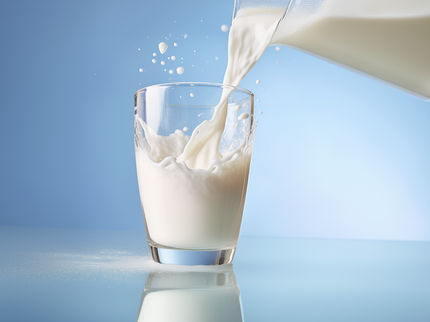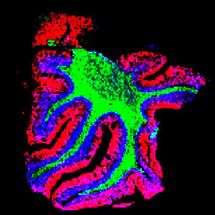Masked ball in the realm of milk proteins
Food chemists are researching how to reduce the allergic reaction to milk protein by using phenolic compounds from apple pomace
Three percent of all infants and children worldwide are allergic to protein in cow's milk. Around 15 percent of them will remain allergic for the rest of their lives.
Dr. Helena Kieserling and Daniel Güterbock from the Department of Food Chemistry and Analysis are researching how to reduce the allergic reaction to milk protein and produce hypoallergenic dairy products based on cow's milk, such as mixed milk drinks, which are better tolerated by allergy sufferers than conventional dairy products. Hypoallergenic means allergen-reduced. The department is headed by Prof. Dr. Sascha Rohn.
"The so-called milk protein epitopes are responsible for the allergic reaction to cow's milk. These are structural areas of the proteins against which the immune system forms antibodies as a defense in some people. Unfortunately, this is unnecessary, as the milk protein epitopes are harmless and pose no real danger to the body," says food chemist Dr. Helena Kieserling. "This misguided reaction of the immune system can be explained by the fact that similar epitopes also occur in proteins from bacteria and viruses. In these cases, however, it makes sense for the human immune system to trigger an immune response in order to render pathogens harmless. The immune system of cow's milk allergy sufferers is therefore unable to recognize that the protein epitope in the milk is not a pathogen."
The immune system is tricked
In order to prevent the immune system from forming antibodies against protein epitopes in cow's milk and thus triggering an allergic reaction, Daniel Güterbock and Dr. Helena Kieserling "mask" the milk protein epitope. "The 'mask' that we put on the milk protein epitope consists of phenolic compounds, which have the effect that the immune system is not prompted to react, or at least to weaken its defense reaction," says Daniel Güterbock. Phenolic compounds are produced by plants. They are their secondary metabolic products and serve the plants, among other things, as protection against predators, have an antioxidant effect or determine the color.
Daniel Güterbock and Dr. Helena Kieserling extract the phenolic compounds from apple pomace, the by-product of apple juice production. In Germany, tons of apple pomace are produced, which has so far been used almost exclusively as animal feed. In future, it would be conceivable to extract the phenolic compounds from other fruit and vegetable pomace.
But how does the masking process work? "We mix the milk with the phenolic compounds from the apple pomace under specific reaction conditions. The compounds react with the milk protein epitope. For our 'masquerade' and ultimately for our goal of producing allergen-reduced dairy products, we use the knowledge from basic research that the phenolic compounds of the plant interact with proteins and use this reaction to trick the immune system," explains Daniel Güterbock.
Excellent idea
For their approach of applying knowledge from basic research to the manufacture of a product, the two scientists were awarded first prize in the "Forum Junge Spitzenforschung" competition organized by the Stiftung Industrieforschung and Humboldt-Innovation GmbH in 2024.
Cow's milk serves as a model for the two TU researchers. "In principle, however, our idea can be applied to all proteins - animal and vegetable. As is well known, there is also a peanut allergy, for example, which is caused by proteins," says Dr. Helena Kieserling, adding: "In most cases, allergies are reactions of the immune system with proteins, in contrast to food intolerances such as lactose intolerance. This is based on the fact that enzymes cannot break down lactose. Allergies and intolerances therefore have different causes, but are often mistakenly used interchangeably."
Ecologically and economically sensible
The approach of reducing the allergenicity of milk proteins by mixing cow's milk or other foods made from cow's milk, such as yoghurt and quark, with plant-based phenol-rich extracts has ecological and economic benefits in addition to the health aspect. "The apple pomace, the by-product of apple juice production - we deliberately don't refer to it as waste - has a second use and thus remains in the raw material cycle. And the economic advantage is that the production of our milk-based mixed drinks can be integrated into the existing production processes of a dairy product manufacturer without additional technical effort and high costs," says Dr. Helena Kieserling.
By contrast, allergen-reduced dairy products currently available on the market are produced at great technological and financial expense. This is because the protein epitope is usually completely broken down into its components in these processes so that the immune system can no longer recognize it. And the breakdown, which scientists refer to as hydrolysis, is extremely complex. In addition, products made in this way are hardly popular with consumers because they have a bitter aftertaste. "Although the sensory tests for our mixed milk drink based on phenol-rich raw materials such as apple pomace are still pending, we assume that the phenolic compounds - especially in combination with conventional fruit preparations - are largely tasteless," says Güterbock.
However, whether the idea will one day become a marketable food depends crucially on the extent to which the two researchers succeed in proving that their product made from cow's milk and phenolic compounds from apple extract significantly dampens the immune response in affected infants and adults. These studies are currently underway.
Note: This article has been translated using a computer system without human intervention. LUMITOS offers these automatic translations to present a wider range of current news. Since this article has been translated with automatic translation, it is possible that it contains errors in vocabulary, syntax or grammar. The original article in German can be found here.





















































